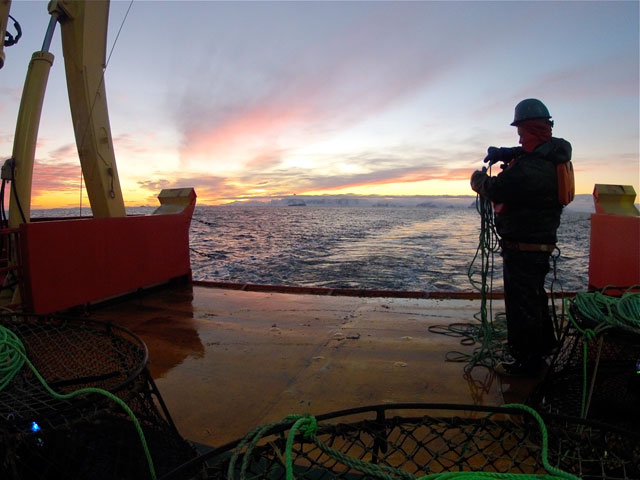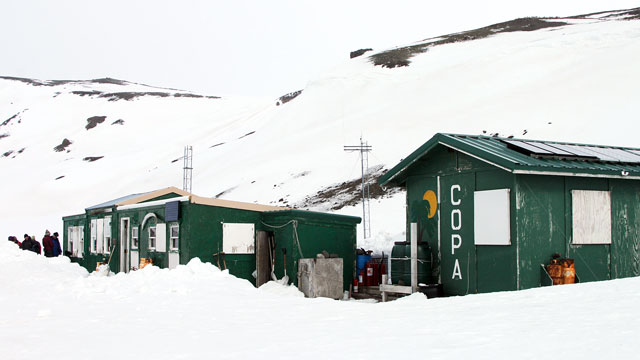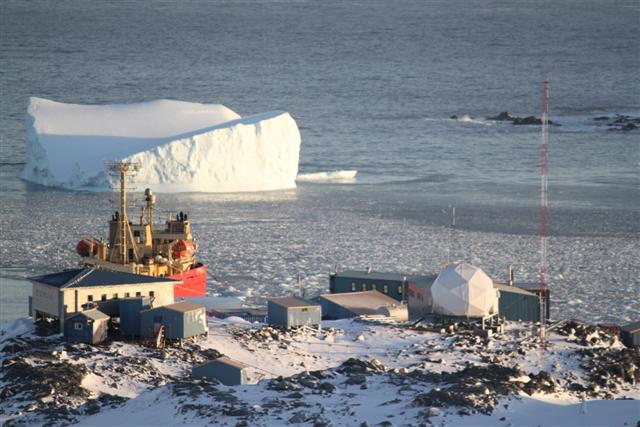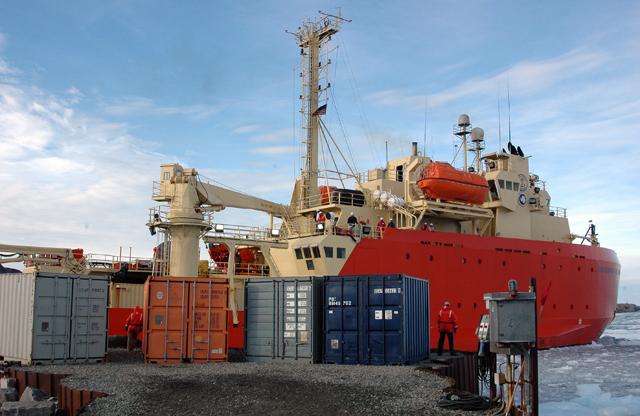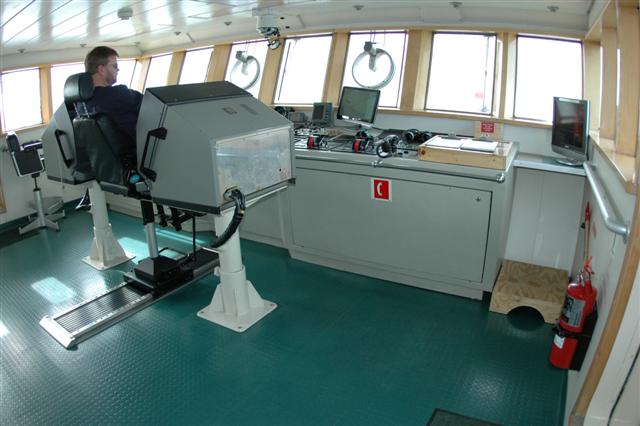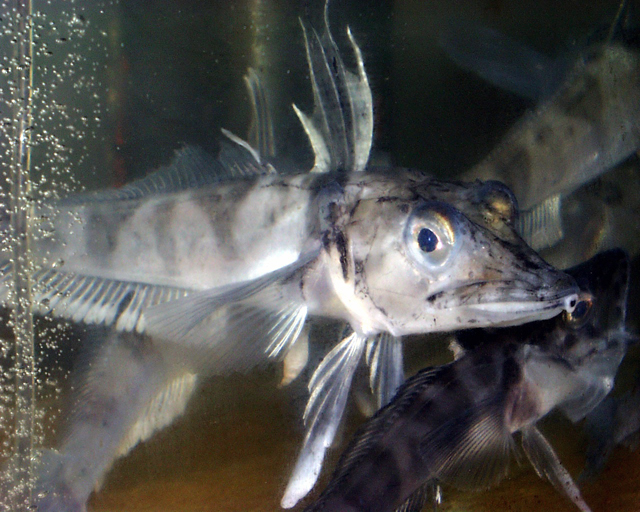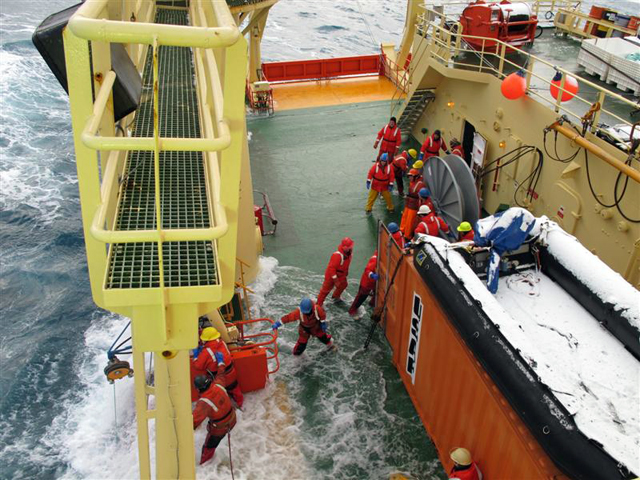|
Vessels Archives for LMG
Posted October 19, 2012
The research vessel Laurence M. Gould The ship had arrived in Punta Arenas, Chile, on Sept. 11, after a 25-day transit from Port Fourchon, La., via the Panama Canal, following a stint in dry dock. The weather the entire trip was excellent, according to Al Hickey, marine projects coordinator, in the daily ship report. 
Photo Credit: Dean Hancock
The research vessel LAURENCE M.GOULD as seen from the bridge of the r/v NATHANIEL B. PALMER before the former left Punta Arenas, Chile.
“These last few days through the Chilean archipelago has presented numerous scenic visits heralding our arrival into early spring in the high latitudes of the southern hemisphere,” he wrote. A week after its arrival in Punta Arenas, the Gould headed south for Palmer Station, the U.S. Antarctic Program’s The port call lasted about six days. On the northbound return trip, the ship supported a project led by James Ledwell The ship conducted a series of 19 conductivity, temperature and depth (CTD) measurements to sample a “tracer” that was released into the water in 2009. See the project website “The Drake Passage was very cooperative for our extended stay in those waters,” Hickey wrote as the cruise drew to a close. Posted May 18, 2012
The research vessel Laurence M. Gould The ship had briefly returned to its port at Punta Arenas, Chile, at the beginning of April before heading back to Palmer Station The Gould arrived at Palmer Station on April 12 to unload its catch in the station’s aquarium before embarking on several more fish expeditions during the month. The ship occasionally battled harsh weather, along with abundant icebergs and brash ice at times, which prevented trawling operations. However, the scientists were able to consistently catch their target species, and made one monster trawl that captured 67 icefish. Posted April 5, 2012
The worst storm in more than 20 years to hit Punta Arenas, Chile, didn’t slow down the research vessel Laurence M. Gould Flash flooding from a storm on March 11 left a “muddy mess” in Chile’s southernmost port town, from which the U.S. Antarctic Program’s Herb Baker, the marine projects coordinator aboard the vessel, reported arriving in town shortly after the floodwaters receded, leaving behind mud and debris in streets, homes and businesses. “After seeing the condition of the town, my thought was that the vessel would be delayed a considerable amount of time before we would be ready for sea,” Baker reported in his first log. “My opinion on this changed the instant I got to the ship and saw the effort that was being cheerfully put forth to make the ship ready for sea.” 
Photo Credit: Nell Herrmann/PolarTREC
A NOAA lab container floats away in the flood that hit Punta Arenas, Chile.
He was especially impressed with the effort put in by the staff at the USAP warehouse that is located near the pier, which was also inundated with water and mud. “The one image I will always remember is walking into the warehouse office near the end of the port call,” he wrote. “The warehouse floor was covered with cardboard to keep people from falling in the halls with mud-covered boots. The portable generator noise was penetrating the walls. “At this time, some of the areas around the warehouse yard that were cleared of wet mud were now drying and creating … dust, but all of the warehouse staff [was] working at their stations, wearing dust masks and working frantically to complete the necessary paperwork for our departure.” The effort also impressed chief scientist Bill Detrich In his weekly ship report, Detrich said that the flood caused extensive damage to the town, while the pier and warehouse were hit particularly hard, forcing the Gould to fuel at a different pier before returning to warehouse area, where personnel “worked diligently and quickly to accomplish the loading of cargo, provisions, and passengers in slightly over two days. Remarkable, indeed.” The ship got under way on March 17 as scheduled, its primary mission to catch various species of Antarctic icefish that Detrich and colleagues use to study their unique adaptations to the Southern Ocean, where surface water temperatures are slightly below freezing. The scientists were mostly skunked at the first stop along the north shore of King George Island, but found much better success at Low Island, where they netted 75 fish. The Gould then steamed to Palmer Station Posted February 17, 2012
January means but one thing aboard the research vessel Laurence M. Gould For the 20th year in a row, the Gould steamed down the western side of the Antarctic Peninsula in support of a long-term study of the region, from Palmer Station The ship cruises along a grid pattern, stopping at some of the same coordinates every year to make oceanographic measurements. In recent years, it added what the scientists call “process studies,” more in-depth surveys at three locations. This year’s process studies focused on so-called biological hotspots where interesting seafloor topography in the form of submarine canyons attracts critters from krill to penguins. 
Photo Credit: Ari Friedlaender
Scientist tags a humpback whale on a previous research cruise in the Antarctic.
In contrast to recent years, when sea ice had cleared out from most of the region early in the summer, there was still extensive ice cover across the southern part of the Palmer LTER study area, particularly around Charcot Island, as the cruise began. One facet of the cruise involves a seabird census at sea, along with a roughly weeklong excursion to Avian Island, where two researchers assess a large Adélie penguin colony of about 65,000 breeding pairs. One special addition to this year’s cruise was a whale study that involved visual surveys and satellite tagging to characterize the distribution and movement of baleen whales in the LTER study areas. As of late January, more than 230 humpback whales had been sighted. In addition, three satellite-linked tags had been deployed on humpback whales in the vicinity of Palmer Station and off the southern tip of Adelaide Island. Four minke whale and six killer whales had also been seen during the cruise. Principal investigator Ari Friedlaender Posted January 27, 2012
The research vessel Laurence M. Gould The Palmer LTER began more than 20 years ago, focusing on the marine ecosystem on the northwestern side of the Antarctic Peninsula. A major focus is understanding the role sea ice plays in the region, which has become one of the fastest-warming in the world since the study began. A review of the program is conducted during each six-year grant cycle. The ship also carried several scientists who are doing a long-term census of seabird populations in the region, a project led by Ron Naveen of Oceanites Inc 
Photo Credit: Peter Rejcek/Antarctic Photo Library
Marine techs aboard the GOULD deploy an instrument during the 2010 LTER cruise.
The cruise itself got off to a rough start, with foul weather and high seas in the Drake Passage between South America and the Antarctic Peninsula. That slowed the Gould, forcing it to move as slowly as possible directly into the wind and seas until the storm abated. After several days at Palmer Station, the ship returned to sea, originally heading to Low Island to begin census survey, led by Heather Lynch at Stony Brook University The Gould then headed to Deception Island, a horseshoe-shaped island formed by the collapse of a massive stratovolcano, a tall, conical volcano. There were two vessels already inside the island’s caldera, so the Gould remained on the outside of the island, where the bird census researchers went ashore for their work while the LTER site review passengers made a separate shore visit. The ship then made a visit to Snow Island for a couple of more bird census landings, before returning to Punta Arenas, where it prepped for the annual January cruise in support of the Palmer LTER. Posted December 9, 2011
The research vessel Laurence M. Gould The projects aboard the Gould are separate but related; both focused on the Southern Ocean salp called Salpa thompsoni. Ann Bucklin with the University of Connecticut 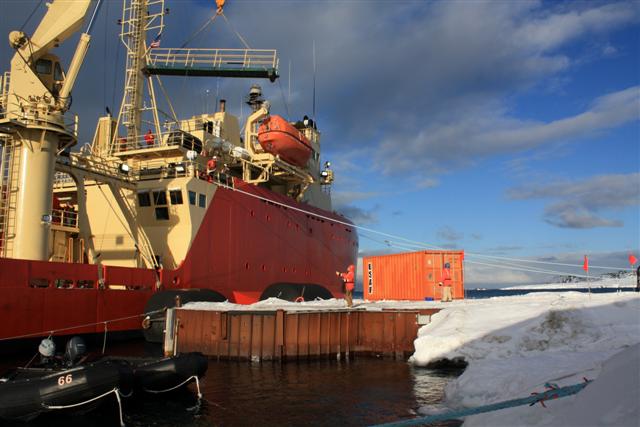
Photo Credit: Zee Evans/Antarctic Photo Library
The research vessel Laurence M. Gould docked at the Palmer Station pier.
Meanwhile, Joe Warren from Stony Brook University Salps are gelatinous, barrel-shaped critters that filter feed on phytoplankton. Scientists who study them in the Antarctic are interested in them, in part, because it appears climate change may favor them over another zooplankton, shrimplike krill. The latter play a key role in the polar food web. Weather proved to be challenging throughout the expedition — not unexpected for the time of year in that part of the western Antarctic Peninsula region. In fact, rough conditions caused the cruise to reshuffle its schedule early in the month during a planned stop to transfer people and gear to the marine mammal research facility at Cape Shirreff on Livingston Island. The camp put-in was delayed until after a stop at Palmer Station Posted November 11, 2011
The research vessel Laurence M. Gould Scientists with the National Oceanic and Atmospheric Administration (NOAA) The National Science Foundation After a smooth camp put-in at Copa on Oct. 11, the ship steamed to Duthier’s Point near the mouth of Andvord Bay to land a Zodiac there to repair a malfunctioning GPS station in the rocks above the bay. It then enjoyed an easy sail to Palmer Station, where it remained until Oct. 20, when it returned north. The northward journey proved to a little rough as the ship entered the dreaded Drake Passage, a stretch of sea between South America and Antarctica. But the Gould made it safely back to port on Oct. 24 before it leaves on a new expedition in early November. Posted October 7, 2011
The research vessel Laurence M. Gould The trip south was slowed by bands of brash ice as the ship passed 60 degrees south latitude. In an area of pancake ice, the Gould had to slow to 5 or 6 knots. En route to the research station, the Gould swung by Duthiers Point with the intention to repair or asses a malfunctioning GPS station located on the point. The ship got close enough to the point to see through the darkness and heavy snowfall that the site would be accessible by small craft, but opted to return for a daylight visit after first visiting Palmer Station to drop off the incoming summer crew and offload fuel. The Gould was scheduled to return to port in Chile on Oct. 2. Posted June 24, 2011
The research vessel Laurence M. Gould The Gould finally broke free and headed to Low Island to collect fish specimens for a project led by chief scientist Kristin O’Brien from the University of Alaska Fairbanks The ship then steamed to Dallmann Bay before heading to Palmer Station with its catch of about 50 fish — about 40 icefish and 12 of their red-blooded cousins. 
Photo Credit: Paula Dell/PolarTrec2011, Courtesy of ARCUS
Scientists Craig Smieth and David Honig sort through marine critters caught during the recent GOULD cruise as part of the LARISSA project.
The vessel made several trips to and from Palmer during the month in support of the icefish team, as well as for scientists associated with the LARISSA (LARsen Ice Shelf System of Antarctica) project A large multidisciplinary research project, LARISSA scientists had set out in 2010 to explore the eastern side of the Antarctic Peninsula where an ice shelf had collapsed. But the ice-choked waters prevented the ship from reaching its destination, forcing the researchers to work largely on the western side of the peninsula. One experiment by members of the team involved lowering a frame with whalebones attached to it a year ago to see what organisms might find it a tasty treat, especially a “bone-eating” worm called Osedax. In May, the whalebone lander was recovered. The lander arrived on the ship’s deck in perfect condition, covered with a variety of whalebone-inhabiting species, according to Craig Smith “We have recovered thousands of specimens from [about] 20 species from the bones, including [four] species of the bone-eating Osedax worms,” Smith reported. “One of the Osedax we call ‘jumbo’ because of its robustness and pencil-sized burrows it makes in the bones. It is clearly a new species.” The Gould eventually returned to Punta Arenas in early June, its last voyage before the Antarctic spring begins and a new summer crew arrives. Posted May 6, 2011
The research vessel Laurence M. Gould The ship left Punta Arenas, Chile, on April 13 in support of a project led by Kristin O’Brien from the University of Alaska Fairbanks Notothenioids have a variety of unusual characteristics. All lack a swim bladder, dwelling almost exclusively on the seafloor, though some possess different strategies for changing buoyancy. Many have antifreeze proteins that help them survive the frigid waters. And one oddball family of the eight that make up Notothenioidei lack hemoglobin, the protein that carries oxygen to the body’s cells. This last family, called Channichthyidae, and its possible vulnerabilities to withstand changes in ocean temperature compared to its red-blooded cousins has drawn O’Brien and her colleagues to the Antarctic Peninsula. Good weather met the ship’s first fishing foray to Low Island after a visit to Palmer Station “Although certain required species can only be caught with the net, we got a decent haul of other desired species with the pots,” reported Al Hickey, the marine projects coordinator on the ship. The Gould eventually returned to Palmer Station to drop off the fish specimens at the station’s aquarium and pick up the station’s remaining summer crew, before heading back to sea. The vessel attempted a quick recon mission to scope out possible field camp areas for an upcoming research project next year, and then proceeded to Punta Arenas to repair the ship’s winch. Posted March 11, 2011
The research vessel Laurence M. Gould The PAL LTER is a ship-based ecosystem study of the western Antarctic Peninsula, one of the fastest warming regions on the planet. Over the month-long cruise, the group surveyed a 140,000-square-kilometer swath, from Anvers Island near the tip of the peninsula to Charcot Island, making measurements of the physical oceanography of the region and collecting water and zooplankton net samples at various locations along a pre-set grid. Seabird researchers surveyed various populations, particularly penguin colonies along the route. 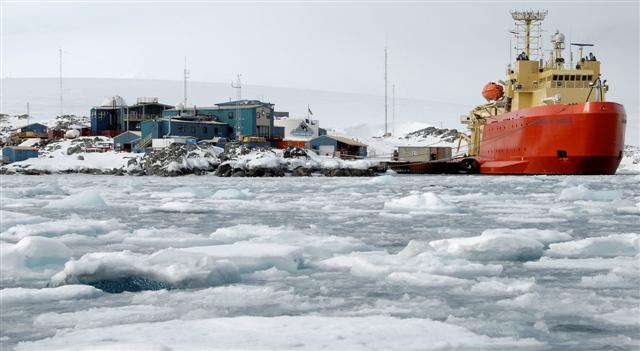
Photo Credit: Andrew V. Williams/Antarctic Photo Library
The research vessel Laurence M. Gould at Palmer Station.
The Gould returned to Punta Arenas, Chile, on Feb. 9 after a brief stop at Palmer Station David Barbeau Ross MacPhee Finally, Joseph Kirschvink The Gould first dropped off a team of science divers at Palmer Station who will be there for several months to study the marine ecosystem in the area. The research vessel then sailed to the Vega Island vicinity to begin a series of island expeditions. Vega is famous for its wealth of fossils, particularly birds. [See previous article: Winging it.] Some members of MacPhee’s team was dropped off at Cape Lamb on Vega Island where it established a field camp its three-week fossil hunt. Members of the other groups also stayed in that area while others made day trips to places with names like The Naze, Humps Island and False Island Point. The various teams are already reporting some interesting findings. From the Kirschvink group: “The finds included many examples of one of the most peculiar species directly related to the still living chambered nautilus: a shelled cephalopod found today living in very deep water (up to 2,000 feet) in the tropical Indo-Pacific. The Kirschvink team also said it found “beautifully preserved pinecones of unknown affinity, something never before reported from these islands. This latter find may prove to have important implications for understanding the evolution of the modern flora.” Meanwhile, the members of the MacPhee team away from Cape Lamb also reported that on The Naze, “a locality that had previously yielded vertebrate material, yielded some interesting paleoenvironmental indicators, including a cone of the plant Araucaria.” The MacPhee field camp party is also having success, saying that their prospecting has yielded “some dinosaur [fossils] and a trove of bird bones to date.” (Palmer Station correspondent Brian Nelson contributed to this report.) Posted February 4, 2011
The month of January in the U.S. Antarctic Program This year’s expedition started a few days late as blizzards in the United States delayed several ship personnel from making the long trip to Punta Arenas, Chile, where the Gould starts its southbound trips for the Antarctic Peninsula. 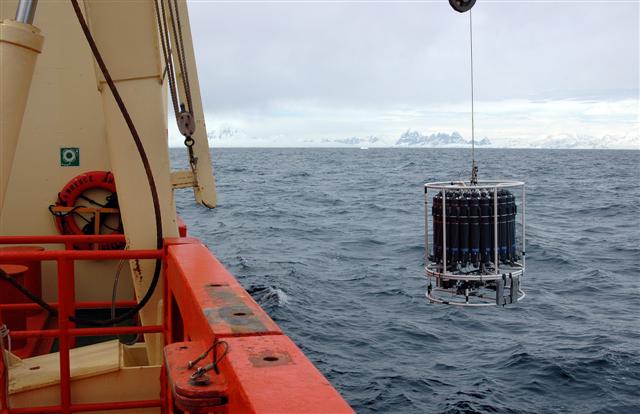
Photo Credit: Peter Rejcek/Antarctic Photo Library
A CTD rosette, which collects physical ocean data and water samples in bottles, is deployed from the GOULD during the 2009-10 season.
The PAL LTER is in the middle of its fourth six-year funding cycle from the National Science Foundation Over the month of January, the group surveyed a 140,000-square-kilometer swath, from Anvers Island near the tip of the peninsula to Charcot Island, making measurements of the physical oceanography of the region and collecting water bottle and zooplankton net samples at various locations along a pre-set grid. Much of this year’s cruise was coordinated with the ASPIRE (Amundsen Sea Polynya International Research Expedition) 
Photo Credit: Lihini Aluwihare
The American team from the GOULD poses for a group photo after its first victory against the British in European football at Rothera Base.
While the month is dominated by 24-hour science operations, the ship’s crew and scientists did take a brief respite at the British Antarctic Survey base Rothera And for the first time in the decade-long rivalry, the U.S. team eked out a win against the British. Early in the second half, Travis Miles took assist passes from Tim Demelo and Kristen Gorman deep in the British end and drilled a shot toward the goal. The ball zipped into the back corner of the net. It would prove to be the only goal of the game. “Our hosts were gracious losers, perhaps secure in their expectation that the Antarctic soccer world would be returned to rights with our next visit,” wrote a humble member of the winning team in the ship’s weekly cruise update. Posted January 7, 2011
The research vessel Laurence M. Gould Chief scientist Joseph Warren That information will help scientists develop a method so that acoustics can be used to assess the abundance and distribution of salps in the Southern Ocean. Salps are one of the primary zooplankton in additional to shrimplike krill in the region. Also aboard the ship is a group led by Ron Naveen, head of Oceanites Inc. After delivering cargo to Palmer Station Rough seas continued to plague the cruise throughout the early days of December, with sustained winds of 40 knots and gusts of nearly 60 knots. The unfavorable conditions forced the science teams and ship crew to reassess priorities and plans, eventually heading for the far calmer waters of the Gerlache Strait. For Warren’s team, the change in location brought a shift in the type of animals captured in the ship’s nets, with far fewer salps and more krill. Naveen’s group assessed 28 sites over 25 days, including 20 landings or definitive counts from offshore. The team members surveyed three Adélie colonies, 13 chinstrap colonies, and nine gentoo colonies. They also developed census data for nine blue-eyed shag colonies and three sites with southern giant petrels. The preliminary results showed declines in all the Adélie colonies and more than half of the chinstrap colonies. Almost all of colonies of gentoos, a subantarctic species enjoying considerable success in the warming Antarctic Peninsula, had grown. Posted November 5, 2010
The research vessel Laurence M. Gould Its first mission this trip was to drop off a field party on King George Island off the Antarctic Peninsula. The Copacabana field camp (Copa) supports a long-term study of the three penguin species of the region — Adélies, chinstraps and gentoos. The project is led by Wayne Trivelpiece Established in 1985 by the NSF, the Copa project was incorporated into NOAA’s Antarctic Marine Living Resources (AMLR) program After a relatively easy crossing of the Drake Passage between South America and Antarctica, the Gould arrived in Admiralty Bay, the put-in area for Copa, on Oct. 9. Poor conditions prevented transporting the field party with their equipment and supplies to island that day. The crew was able to put in the camp the next day, sandwiched between deteriorating weather conditions. The ship headed to Palmer Station Posted July 9, 2010
The research and support vessel Laurence M. Gould The ship had been supporting a research cruise led by Bill Detrich The Gould departed Palmer Station for Punta Arenas on June 4, stopping by the Chilean research station, Base Presidente Eduardo Frei Montalva, on King George Island en route to pick up an additional passenger. After a relatively smooth crossing of Drake Passage between the tips of the two continents, the Gould arrived in Punta Arenas on June 8. It will be on standby until September, when Palmer Station ramps up for the summer field season. Posted June 11, 2010
The ARSV Laurence M. Gould Detrich and his colleagues are studying Antarctic icefish, which possess unique abilities to survive in the near-freezing waters of the Southern Ocean. [See previous article: The bloodless icefishes.] The expedition began April 10 from Punta Arenas, with the Gouldfishing for icefish and shuttling passengers to and from Palmer Station. The vessel returned north at the end of April to drop off outgoing summer crewmembers from the station. Its return port call at Palmer Station in early May proved difficult, as strong winds delayed cargo operations for about two days. The Gould found better weather once back under way to Elephant Island, though conditions again deteriorated once the ship reached its location, hampering its fishing operations somewhat. 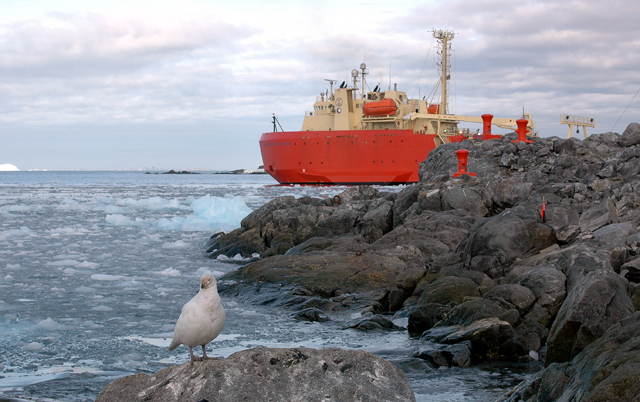
Photo Credit: Peter Rejcek
The Gould near Palmer Station earlier this year, with a sheathbill in the foreground.
The ship then turned toward Low Island, but ice slowed its progress. Weather continued to prevent the ship from deploying some equipment but a night of trawling pulled in 26 icefish, including a number of “high-value specimens” that the scientists were keen to keep alive, so the ship returned to Palmer Station, which has an aquarium. A couple of days later, the ship headed to an area called Banana Trench, with depths of about 900 meters, much deeper than its other fishing locations. The Gould then headed to Renaud Island, where poor weather forced a return trip back to Palmer. The ship made several more fishing forays, particularly around Dallmann Bay, before returning to Palmer Station at the end of the month. It was scheduled to head north back to Punta Arenas in early June. Posted May 7, 2010
The ARSV Laurence M. Gould A professor of biochemistry and marine biology at Northeastern University In the early part of the expedition, the Gould fished in Dallmann Bay for about 36 hours by setting 16 baited fish traps before switching to trawling operations, despite heavy swells from an earlier storm. The scientists and crew caught several dozen fish, representing at least three different species, before heading to Palmer Station to put the fish in the station’s aquarium and to offload cargo. The ship then returned to sea for a second round of fishing. The rough seas had smoothed out by then, according to a report by Herb Baker, Marine Projects coordinator on the cruise. “The calm conditions are a welcome change from the bashing we received during last week’s fishing trip,” he wrote. The ship returned to Palmer Station at the end of the month to drop off more fish specimens. It was scheduled to head north back to Punta Arenas to drop off some members of the Palmer Station support crew who completed their summer season work. The southbound cruise had carried several members of the Palmer Station winter crew. After a brief port call, the ship will head south again for part two of Detrich’s icefish expedition. |
Home /
Around the Continent /
Vessels Update (LMG) Archives
"News about the USAP, the Ice, and the People"



For USAP Participants |
For The Public |
For Researchers and EducatorsContact UsU.S. National Science FoundationOffice of Polar Programs Geosciences Directorate 2415 Eisenhower Avenue, Suite W7100 Alexandria, VA 22314 Sign up for the NSF Office of Polar Programs newsletter and events. Feedback Form |

